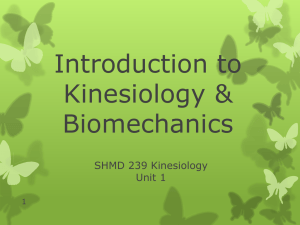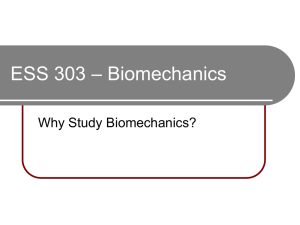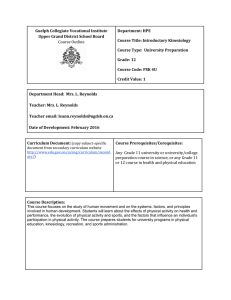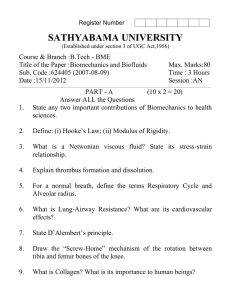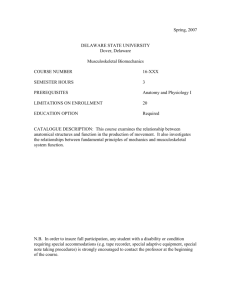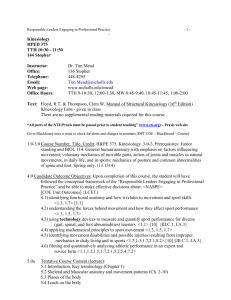SPORT BIOMECHANICS S2 PRODI IK - PPS UNY DR. RIA LUMINTUARSO
advertisement
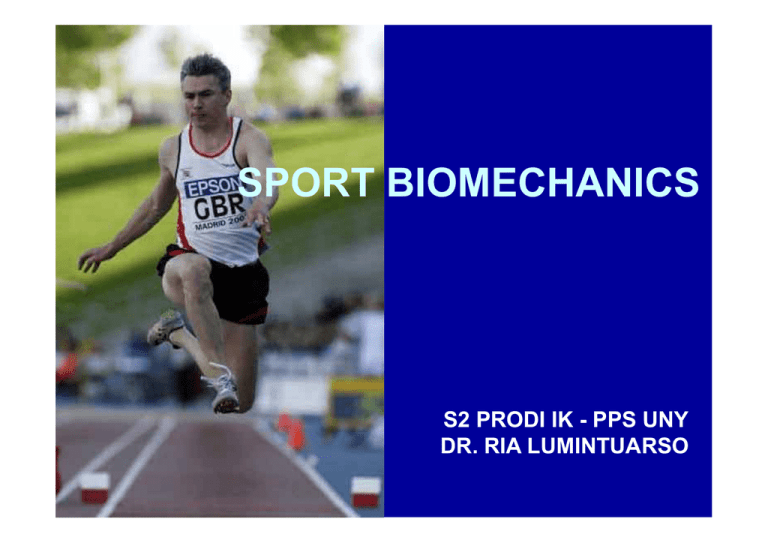
SPORT BIOMECHANICS S2 PRODI IK - PPS UNY DR. RIA LUMINTUARSO I. Sport Sciences can be divided in to 4 Areas : 1. 2. Biological Sciences - Biochemistry of exercises - Sport Physiology - Sport Medicine - Sport Biomechanics & Kinesiology - Sport Nutrition, etc. Behavioral Sciences - Sport Pedagogy - Sport Psychology - Sport Sociology - Motor Learning 3. The Humanities - Sport Philosophy - Sport History - Sport Theology 4. Varia - Sport Management - Sport Infrastructure - Sport Communication and Mass Media - Sport Law (Olympic Science Congress, Canada, 1976) Struktur ini hampir sama dengan Pohon Ilmu Keolahragaan hasil dari Semiloka Ilmu Keolahragaan 1998 di Surabaya. Bandingkan dengan teorinya Prof. Haag tentang Sport Science. II. KINESIOLOGY AND BIOMECHANICS • KINESIOLOGY. – Originally from Greek terminology Kinein means Movement/motion and Logos mean Science. – The Scientific Study of Human Motion is known as KINESIOLOGY. – KINESIOLOGY is devided into two special study field: • Anatomic Kinesiology • Mechanical Kinesiology – During recent years, the term “Mechanical” has been replaced by BIOMECHANICS. II. KINESIOLOGY AND BIOMECHANICS • BIOMECHANICS. – Studying and analyzing human in motion, sport object motion, and forces acting upon these animate and inanimate bodies is known as BIOMECHANICS (Northrip: 1974) – BIOMECHANICS may be considered to be that aspect of the science of movement (KINESIOLOGY) which has to do with the effect forces have upon the state of motion or rest of living bodies. (Wells and Luttgens: 1976) II. KINESIOLOGY AND BIOMECHANICS • The Professional : • The importance of a knowledge of Biomechanics to a pro’ - coach depends to a certain extent on the sport that he is coaching. A cross-country coach, concerned primarily with cardiovascular and muscular endurance and only to a very limited extent with techniques, will clearly benefit less from a knowledge of Biomechanics than will a coach of baseball, football, gymnastics, or swimming, in all of which techniques play a much larger role, or start technique for 100 m dash, high jump or hammer throw. III. Function of Biomechanics in Sport 1. 2. 3. To evaluate or analyze series of performance of champion. For example: To analyze which movement is useful and which one should be avoided. (Emile Zatopek, Valery Brumel, or Javier Sotomayor of Cuba, World Record Breaker in High Jump: 2.44M). Adaptation to new technique caused by new rules. For example: In swimming, due to change of new rules in competition some techniques in turning are introduced. Finding or alteration of new technique due to development in the equipment used by athletes. For example : The use of sponge-faced table tennis bat, the fiberglass vaulting pole, etc. IV. The Study of Biomechanics is Devided in to two areas : Statics and Dynamics. 1. Statics, cover situations in which all forces acting on a body are balanced and the body is in equilibrium. With a knowledge of the principles of statics one may have a better understanding of levers and greater ability to solve problems such as locating the body’s center of gravity or the center of buoyancy. 2. Dynamics, that branch of Biomechanics which deals with bodies subject to unbalanced forces is called dynamics. Principles of dynamics explain circumstances where an excess of force in one direction or turning force cause an object to change direction. Principles of work, energy and accelerated motion are covered in the study of dynamics. V. The terms KINEMATICS and KINETICS are also part of the vocabulary of the study of mechanics. • KINEMATICS has been referred to as the geometry of motion. It describes the motion of bodies in term of time, displacement, velocity and acceleration. The motion occurring may be in straight line (Linear Kinematics) or about a fixed point (Angular Kinematics) Kinematics is not concerned with the forces which cause the object to move. That is covered in the Kinetics of motion. V. The terms KINEMATICS and KINETICS are also part of the vocabulary of the study of mechanics. • • KINETICS is that branch of mechanics which considers the forces that produce or change motion. Admittedly the most complex of biomechanics studies, it is the area least developed in Physical Education and Sport, and of most challenge to research today. (Wells & Luttgens, 1976) Biomechanics is an applied science supported by: Anatomy, Physiology, Physic. V. The terms KINEMATICS and KINETICS are also part of the vocabulary of the study of mechanics. • KINEMATICS is that branch of mechanics that is concerned with describing the motion of bodies. Thus Kinematics deals with such things as how far a body moves, how fast it moves, and how consistently it moves. It is not concerned at all with what causes a body to move in the way it does. (James G Hay: 1978)
